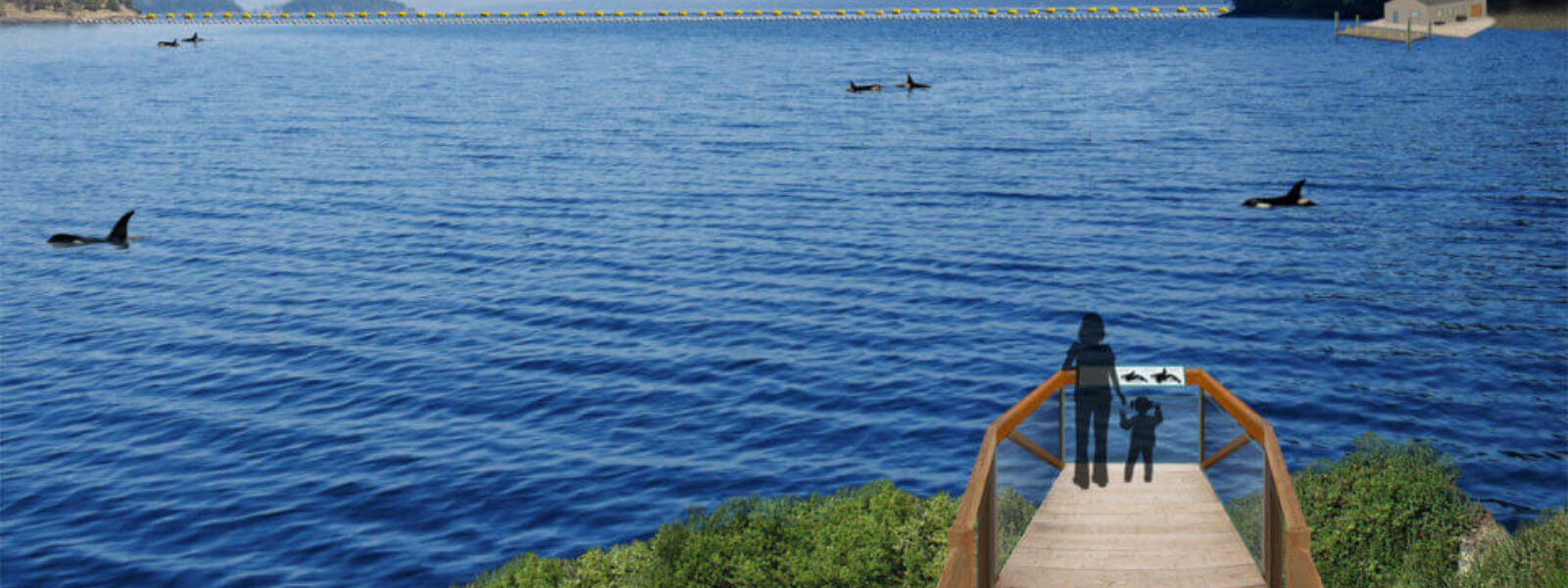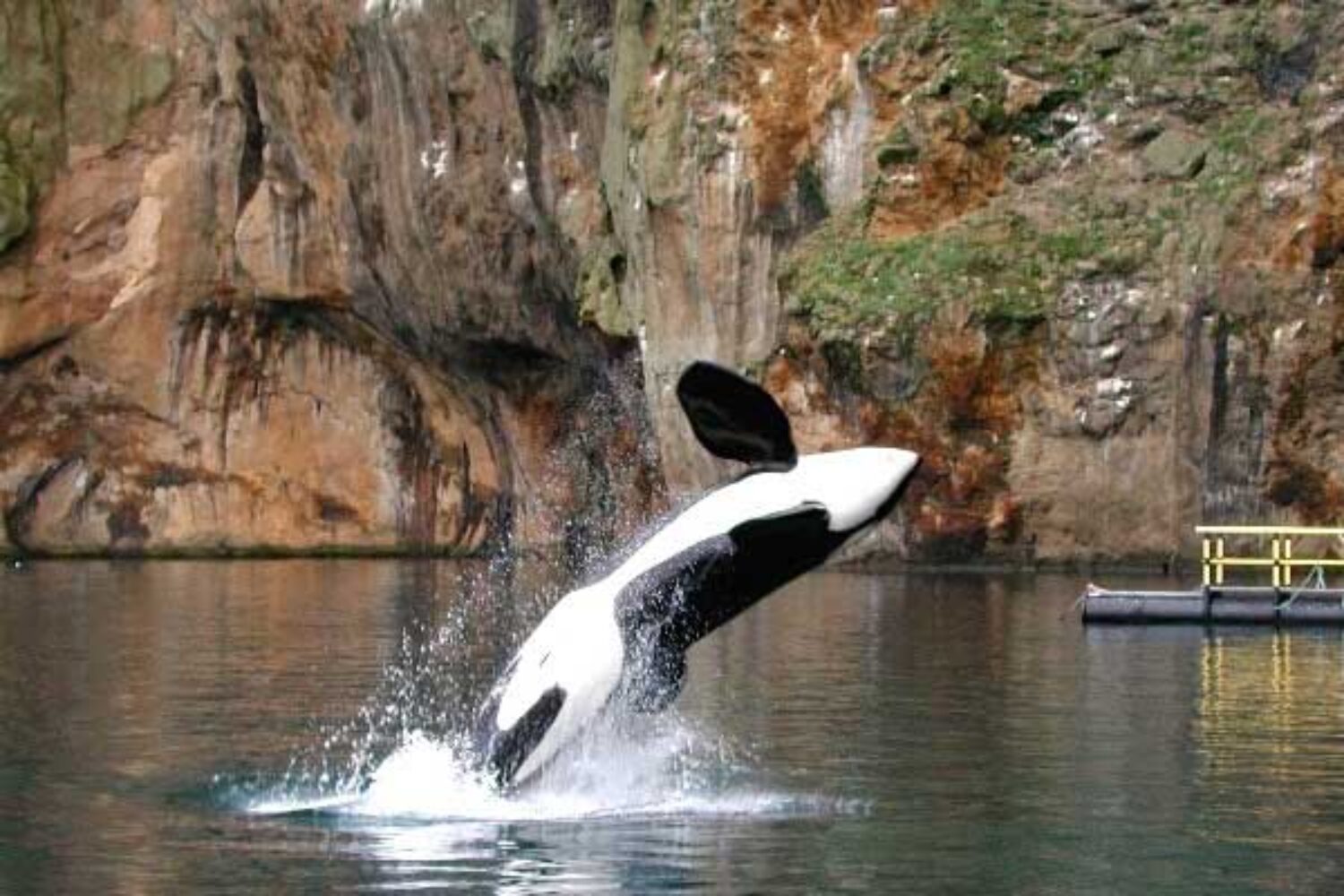
Seaside Sanctuaries for Captive Orcas
By Mark J. Palmer
Seaside sanctuaries are superior, semi-natural retirement centers for cetaceans, including orcas, now kept in concrete tanks. Sanctuaries are built as netted enclosures in the ocean, such as coves netted off so they contain the cetaceans but allow free movement of water, fish and wind. Orcas and other cetaceans are fed and receive veterinary treatment, but do not have to perform tricks for entertainment. There are no interactions with the public, such as touching, feeding or swimming with the animals. Orcas can just be themselves for the balance of their lives.
In the words of Dr. Lori Marino, President of the Whale Sanctuary Project and an expert on cetacean brains: “A sanctuary is a place of refuge and protection but also restoration, returning the animal to the closest approximation to a natural life.”
Captivity Kills Orcas
Captivity In barren cement tanks is devastating to orcas. They live shortened lives marked by stress and boredom. In SeaWorld parks alone, 53 captive orcas have died over the years. They break their teeth, threatening mouth infections. They are given drugs like antacids, anti-anxiety formulations, anti-depressants, drugs to speed up breeding (meant for livestock), and antibiotics to stem infections. While SeaWorld is no longer breeding orcas, they are forced to breed in other foreign aquariums such as China. SeaWorld and other facilities keep captive orcas hungry during the day so they will do the tricks required for daily “shows.”
Orcas are too big, too social, too wide-ranging, and too intelligent to be stranded in small concrete coffins for the rest of their lives. We can do better by retiring captive orcas and other cetaceans to seaside sanctuaries.
Benefits of Sanctuaries
- Seaside sanctuaries provide much more space – both in volume of water and depth – for orcas and other cetaceans to swim in, being as much as 100 times larger than the largest concrete tank, a vast improvement.
- Seaside sanctuaries allow orcas to experience real ocean conditions, such as tides, the wind, and currents. They also allow interactions with fish and other marine life.
- Seaside sanctuaries have far more variation than concrete tanks, including much more interesting sea floors with vegetation.
- Sanctuaries allow much more freedom for orcas, reducing crowding and negative interactions that can occur when unrelated cetaceans share confined, close quarters.
- Orcas would not be deprived of food, as they would no longer be required to do “shows” for the public in order to be fed.
- Some non-invasive research on orcas and other cetaceans would be possible in a sanctuary, such as studies of orca communications and observations of behavioral interactions.
- While most whales and dolphins would live out the rest of their lives in a sanctuary, in some rare cases, individual cetaceans may be able to transition from a sanctuary back to the wild. The sanctuary provides a training base for the orca and other cetaceans to learn independence skills, notably catching fish, as well as opportunities for experts to determine if an orca or other dolphin is ready to swim freely and thrive in the ocean.
- Seaside sanctuaries also provide rehabilitation opportunities for stranded and injured wild cetaceans. Veterinary care would be provided through medical pools. There are roughly 2,000 strandings of whales and dolphins annually around the world, and while most animals are dead or die shortly after stranding, some are left to die that could benefit from rehabilitation and release in a seaside sanctuary.

Keiko breaches in his sanctuary in Iceland, prior to swimming free. The same area is now used as a sanctuary for two captive beluga whales. Photo Credit: Free Willy/Keiko Foundation
Existing and Pending Seaside Sanctuaries
SEALIFE Trust Beluga Whale Sanctuary, Heimaey Island, Iceland. The sanctuary is located in the same place as Keiko’s sanctuary, where Keiko (orca star of Free Willy) lived for more than three years relearning skills that enabled him to successfully swim freely into the North Atlantic. Currently, the sanctuary is home to two beluga whales from a Shanghai aquarium in China. The sanctuary could hold up to ten beluga whales in the future.
Whale Sanctuary Project, Port Hillford, Nova Scotia, Canada. A new seaside sanctuary is taking shape in Canada to house orcas, beluga whales, and cold water, smaller dolphins. It could be opened as early as 2024.
Aegean Marine Life Sanctuary, Lipsi Island, Greece. Expected to be the first permanent seaside sanctuary for warm water dolphins, including captive dolphins and injured or stranded wild dolphins, sea turtles and monk seals. Onshore support buildings have been completed.
Other Examples: Temporary sea pens have been employed in Turkey, Bali and South Korea to hold dolphins until they could be released into the wild. There are plans to establish a new sanctuary in Norway for the beluga whale Vladimir, who is believed to have escaped from Russian facilities where dolphins are being used for military purposes. The National Aquarium in Baltimore is seeking a sanctuary to retire its bottlenose dolphins in the Caribbean. With the death of the orca Tokitae (also known as Lolita), plans for a seaside sanctuary for her in the Pacific Northwest will be abandoned.
The captivity industry has made billions of dollars year after year through exploiting captive orcas and other dolphins. However, the tide is turning and worldwide pressure continues to grow for the captivity industry to retire captive cetaceans to seaside sanctuaries.
**********************************
